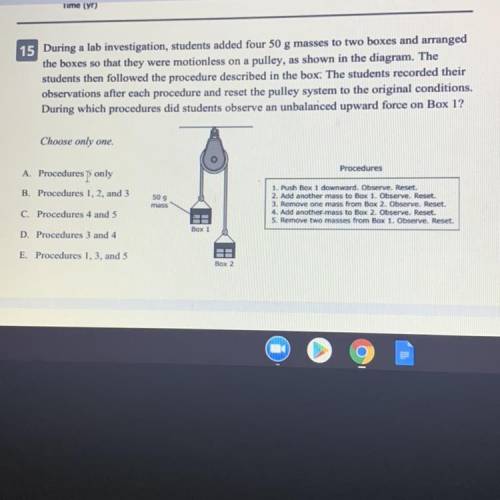
Chemistry, 10.02.2021 21:50 catherineguyen3216
Time (y)
15
1-
15 During a lab investigation, students added four 50 g masses to two boxes and arranged
the boxes so that they were motionless on a pulley, as shown in the diagram. The
students then followed the procedure described in the box. The students recorded their
observations after each procedure and reset the pulley system to the original conditions.
During which procedures did students observe an unbalanced upward force on Box 1?
1
Choose only one.
Procedures
A. Procedures only
B. Procedures 1, 2, and 3
50 g
mass
1. Push Box 1 downward. Observe. Reset.
2. Add another mass to Box 1. Observe. Reset.
3. Remove one mass from Box 2. Observe. Reset.
4. Add another-mass to Box 2. Observe. Reset.
5. Remove two masses from Box 1. Observe. Reset.
C. Procedures 4 and 5
Box 1
D. Procedures 3 and 4
E. Procedures 1, 3, and 5
Box 2


Answers: 3
Another question on Chemistry

Chemistry, 21.06.2019 14:00
Which of the following best defines homeostasis? forming identical cells breaking down glucose maintaining stable internal conditions increasing an organism's temperature
Answers: 3

Chemistry, 22.06.2019 00:30
13. calculate the initial concentration (before precipitation) of carbonate ions after the addition of each 0.05 ml of solution b to the 1.00 l beaker of solution a. divide the work among group members and write the answers in the table in model 3. assume the volume change as solution b is added is negligible. 14. notice the initial concentrations of zn2+ - and cu2+ in the table in model 3. a. explain how these were obtained from the data in model 2. b. as solution b is added and precipitates form, do these initial concentrations change? 15. use the data in model 2 to indicate the presence of precipitate (either znco3 or cuco3) after each 0.05 ml addition of solution b in model 3. 16. use the initial concentrations of carbonate ions and zinc ions to calculate the reaction quotient, qsp for the zinc carbonate scenarios in model 3. divide the work among group members and write the answers in the table in model 3. 17. use the initial concentrations of carbonate ion and copper(ii) ions to calculate the qsp for the copper(ii) carbonate scenarios in model 3. divide the work among group members and write the answers in the table in model 3.
Answers: 3

Chemistry, 22.06.2019 01:30
If 34.2 grams of lithium react with excess water, how many liters of hydrogen gas can be produced at 299 kelvin and 1.21 atmospheres? 2 li (s) + 2 h2o (l) yields 2 lioh (aq) + h2 (g)
Answers: 3

Chemistry, 22.06.2019 02:30
The is a particle with one unit of positive charge a. proton b. positron c. electron d. nucleus awnser quick it is a important science test!
Answers: 2
You know the right answer?
Time (y)
15
1-
15 During a lab investigation, students added four 50 g masses to two bo...
1-
15 During a lab investigation, students added four 50 g masses to two bo...
Questions

Mathematics, 12.08.2020 18:01

Physics, 12.08.2020 18:01


Mathematics, 12.08.2020 19:01

History, 12.08.2020 19:01







English, 12.08.2020 19:01

Mathematics, 12.08.2020 19:01


History, 12.08.2020 19:01

Biology, 12.08.2020 19:01







